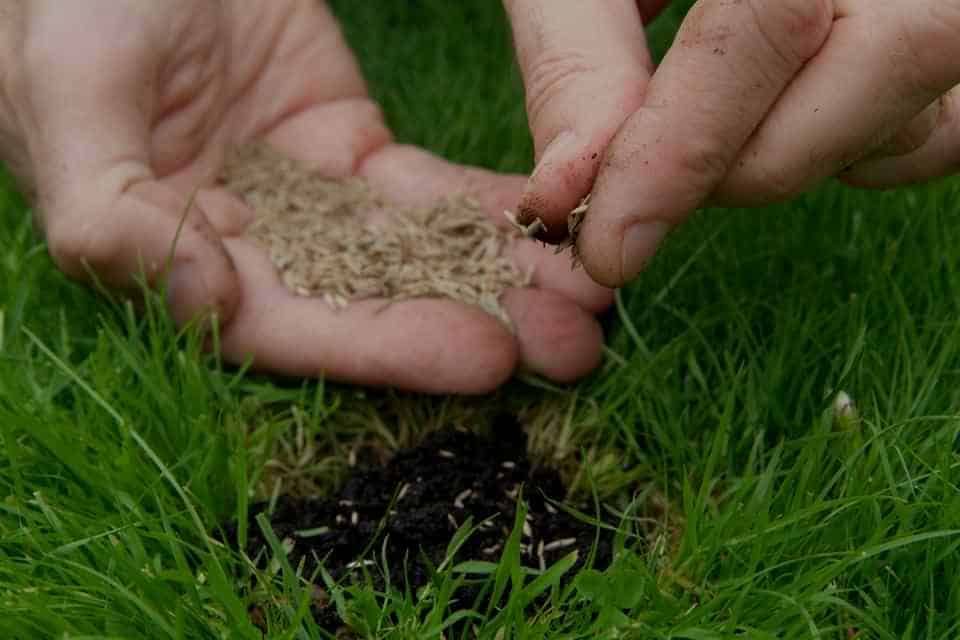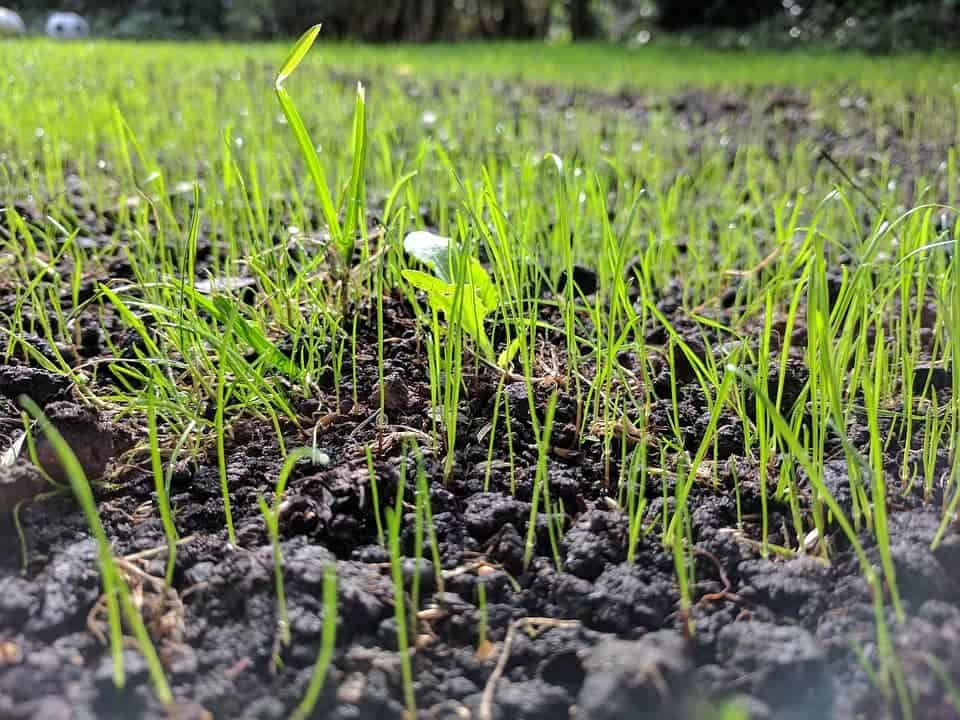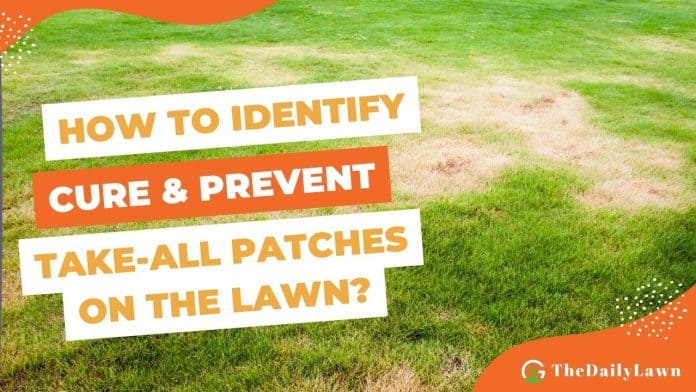I am sure you are not unfamiliar with the name, Take-all patches if you have a lawn. Among all the irritating and stubborn lawn diseases, it is a widespread one. That’s why many new lawn owners ask how to get rid of take-all patches from the lawn.
They also want to know how to kick this fungus out of their lawn for good. Well, I wonder if that might be difficult, especially if you don’t follow a particular way to treat your lawn. Once you make sure to take the right move, it will be very easy to kick out this stubborn fungus.
As we are trying to find out all common lawn diseases to help you get rid of them, this time, we will diagnose the fact, Take-all patches on the lawn. So, if your lawn is already suffering from this disease or you are just curious about it, make sure to check all the essential factors below.
What Is Take-All Patch?
 Basically, the take-all patch is a type of fungal disease as a fungus attack causes it. The scientific name of this specific fungus is Gaeumannomyces graminis. You must be familiar with many different disorders like dry patches or fairy rings on the lawn. While most of them are easy to control, take-all patches are not like that.
Basically, the take-all patch is a type of fungal disease as a fungus attack causes it. The scientific name of this specific fungus is Gaeumannomyces graminis. You must be familiar with many different disorders like dry patches or fairy rings on the lawn. While most of them are easy to control, take-all patches are not like that.
This disease is primarily found in lawns with specific grass types. Bermuda, St. Augustine, and Zoysia are especially at threat of getting attacked by this kind of fungi. And they spread on the lawn mainly from midsummer till Autumn.
Aside from those lawn grasses, bentgrass lawns are also at risk for this prominent disease as well. That’s why golf courses are at high risk to it. A lawn with alkaline soil is also suitable for this kind of fungi too.
Causes of Take-All Patch on the Lawn
 Take All Patches can take over your lawn if the soil is moist, and the most common victim is bent grass. However, it can also harm stolons and roots and end up killing your lawn. So, it is very important to learn the basic causes of this disease. Its auspicious conditions are given below.
Take All Patches can take over your lawn if the soil is moist, and the most common victim is bent grass. However, it can also harm stolons and roots and end up killing your lawn. So, it is very important to learn the basic causes of this disease. Its auspicious conditions are given below.
- Gaeumannomyces graminis are the fungi that cause the take-all patches, and they grow in the summer at temperatures around 12 to 18 degrees Celsius. So, excessive heat and drought are the main cause of this disease.
- Overwatering and poor drainage will keep the soil muddy and help generate this disease.
- Excessive rain in chilly weather, mild winter weather, and shade will also prevent the moderate sunlight from reaching the soil, leading to Take All patches on the lawn.
- Septic spray heads and Night time irrigation schedule is other causes affecting your lawn.
- The lawn soil that has lower disease-resistant capability can get attacked by this disease.
- If you mow your lawn too high, eyelet holes might remain, eventually dumping the soil and causing Take All Patch.
So, these are the main causes; the fungus can take over your lawn. As you are now aware of the reasons, it is better to top take the necessary steps to prevent it. I will tell you about it in the next section. But first, let me learn about how you can identify take-all patches on the lawn.
Ways to Identify Take-All Patches on Your Lawn
Take All patches that appear on your lawn when it goes under drought stress due to summer heat. Many people mistake it for some other lawn diseases very often. But the take-all patches need to be identified and cured rightly. Here are some symptoms that might help you identify this disease.
- There will be patches of grass together with reddish leaves, particularly when the lawn is under attack by The take-all Patches. Soon you will see the affected grass turn brown as it dies.
- These patches are often mistaken for Dollar spot disease as they can be small, around 1 to 2 cm in diameter.
- The grasses, including broadleaved weeds and annual meadow grass, are more resistant to this disease and can grow in the midst of patches.
- These grasses can grow up to 3 feet in height if you do not interfere in their medicating.
- You will notice that the dead grass will soon turn black as it thawed, and you can pull out easily.
How to Cure Take-all Patches?
Once you are sure that your lawn is suffering from take-all patches, you need to get rid of them immediately. You may find different fungicides in the markets that claim to remove take-all patches. Buying a fungicide alone may not do it perfectly. Your attempt to help your lawn in the right way can only help it with the fungicides. So, let’s see what you should do to remove this fungus.
Step 1: Get Rid of the Weeds
 Patches of dead grass become visible when the weed has grown frequently in that place. That’s why it is necessary to do something to get rid of the problem. It’s easier to cure the problem before it is too late.
Patches of dead grass become visible when the weed has grown frequently in that place. That’s why it is necessary to do something to get rid of the problem. It’s easier to cure the problem before it is too late.
Weed-killer spray is helpful in the first one or two weeks when the weed has just started to take over the lawn. But Before it covers the whole lawn, you have to concentrate on the affected area and medicate them with appropriate weed killers.
We suggest you use a spot spray in the first place. Also, you can use weedkillers like Resolva For Lawns, Scotts Weedol, and Evergreen Complete 4-in-2.
Step 2: Remove Debris and Trash
This disease will allow more moss and dead patches of grass which are equally harmful as weeds. To remove these moss and the patches of dead grass, you can simply use a springbok rake or powered lawn rake.
Trashes on your lawn create a hindrance between the soil and grass. So if there is so much trash and debris, it will become tougher for the roots to provide essential nutrients to the grass leaves. Plus, it obstructs the germination of newly sowed seeds.
You can use a big powered rake to get rid of this debris. You can always find power rakes of different sizes in the market; some are double in size as a scarifier. However, a bigger rake will reduce physical exhaustion as well as save your time too. You can use this same rake for the next step too.
Step 3: Remove Extra Thatch
Extra thatch is also an alarming condition for your lawn, and Take-All is the reason behind it. Scarifying here is the best solution to remove excess thatch, which can directly contact grass seed and soil.
It also protects your lawn from infections, dead grass roots, stolons, or crowns. The lawn may look a bit weird after scarifying, but it is the ultimate solution to remove thatch and keep healthy grass on your lawn.
Step 4: Overseed to Cover the Empty Land
 Once you have properly raked and scarified the lawn, there will be plenty of vacant soil. And there you can sow new grass seeds. Now, make sure to remove all the affected grasses and then sow new seeds.
Once you have properly raked and scarified the lawn, there will be plenty of vacant soil. And there you can sow new grass seeds. Now, make sure to remove all the affected grasses and then sow new seeds.
In this case, you should choose the type of grass seed depending on your lawn type. You can select the seed from the ryegrasses. Fescues are also good in this case.
A Multipurpose seed that has both Fescues and ryegrass is more appropriate for a family lawn. And if you wish to have an ornamental lawn, you should use a combination that encompasses fescue grasses only.
Step 5: Apply Fertilizer
Normally, grass seeds take time to germinate and grow. But if you want better growth of grass, you have to fertilize your lawn properly. In this case, pre-seeding fertilizer works the best. Generally, normal lawn fertilizer is rich in Nitrogen, but Nitrogen is harmful to new seeds.
So, you better choose a pre-seeding fertilizer that is free from Nitrogen. It will be better for your lawn to try something encompassing with a higher concentration of phosphorus and potassium.
Step 6: Make an Appropriate Environment for the Seeds to Germinate and Grow
 The general environment of the soil may not be appropriate for the seed to germinate and proliferate. Indeed, it is essential for the seed to get in the soil perfectly. Brushing, raking, threading, and rolling are some best ways to make contact between the grass and the soil.
The general environment of the soil may not be appropriate for the seed to germinate and proliferate. Indeed, it is essential for the seed to get in the soil perfectly. Brushing, raking, threading, and rolling are some best ways to make contact between the grass and the soil.
You can simply use a brush to work on the lawn and use a roller to thrust it. A back of a rake also can be used, and then string or heel the lawn as well. Also, ensure to keep the lawn tidy and clean before the seeds germinate.
Step 7: Water the Area
You are in the final step, and like most other lawn jobs, you have to end it by watering the area properly. You have to water your lawn to keep the soil moisturized to aid germination. The seeds can easily get dried and rotten if you don’t water the lawn.
In most cases, Take-All patches affect the lawn in Autumn. So, treating the lawn in Autumn ideally would be a great help. Eventually, frequent rain in Autumn will help your lawn too. Otherwise, you need to water the lawn for an hour every couple of days, especially when the weather is dry.
A Sprinkler system is a great help to keep your lawn moist and nourished. However, watering too much can cause trouble too. Heavy watering can create a risk of drowning the grass seeds and washing them away.
Effective Ways to Prevent Take-all Patches

If you look up the cure section, then that would be enough arrangements for prevention too. However, there are some other ways still left that might help you to prevent it from the outset. Here is how you will do it.
The initial stage is quite simple; you can choose your lawn to be overseeded with seed mix. And rake your soil properly, especially in the time of Spring and Autumn. Your main intention here is to remove the moss.
Remember that ryegrass and fescues will only bring the zestfulness to your lawn against Take All patches. Therefore, past overseeding treatments, including scarifying, are crucial. Scarifying your lawn every year will help to cut down thatch as well.
The application of slow-release fertilizer will do good for your lawn. So, do not forget to add up a good quality fertilizer once a year. In addition, a weedkiller will provide a weed-free lawn, will not bring any moisture to the soil, and prevent Take All patches automatically.
FAQ
Q: What fungicide is largely used to cure Take-All Patches on the lawn??
A: QoI and DMI are the best-known fungicides to work against Take-All patches. You can apply these fungicides around the month of September and November. And it works effectively in 5cm depth when the soil temperature is 7 to 16 degrees Celsius.
Q: What is the outlook of Take-all patches?
A: It appears typically as circular, small, light brown to reddish brown patches. You will find the patches approximately 8 to 24 inches in diameter. This disease is more likely to come into sight during environmental stress.
Q: Are there any interconnections between Take-All root rot and Take-All patches?
A: Yes, Take-all root rot and the patches have a connection, and even, they are the same things. Basically, both the term refers to the same turf fungal disease and is caused by the same Gaeumannomyces graminis var. This happens exceedingly during the Spring and Summer season.
Q: In What particular way did take-all disease spread to other grasses?
A: You will see the affected area takes time to heal, and in most cases, the centers are occupied by weeds and Fescues. So, it is important to get rid of Take-All before the patches spread all over.
Q: Does mowing the lawn in brown patches bring more possibility of spreading the fungus?
A: Yes, mowing the affected area can spread the fungus widely. Sometimes, it can be associated with wheels and cutting blades. The fungi can move from the affected area to healthy grass by the mower’s parts. Also, the clippings of the affected area can spread as well. To avoid such risks, you must clean it properly after using it every day.
Bottom Line
Let me remind you one thing clearly. Take-all patches are not any silly and easy-to-control lawn disease like red thread and pink patches. It is alone enough to kill your lawn within a short time. So, never take the issue lightly.
I have tried to describe the process of treating take-all patches with all my known information. Eventually, I have broken the entire process into several steps so that you can understand the process perfectly. So, make sure to follow the steps sequentially.
Please remember that a lawn is a susceptible fact. And many different bacterial and fungal diseases can attack your lawn. So, even if your lawn is not suffering from any particular diseases, make sure to learn about them so that you can identify the particular disease instantly on your lawn.
Well, next time, I will inform you about another lawn disease. If you know someone who is upset about his unhealthy lawn with take-all patches, please share this content with him. Thank you for being so supportive.
